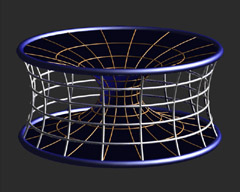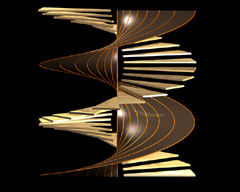|
|
Touching Soap Films |
|
|
|
Geometric Properties III
Furthermore, minimal surfaces now no longer need to be identified with soap films. Every soap film is indeed a minimal surface, and every sufficiently small piece of a minimal surface can be produced as a soap film in a wire loop that conforms exactly to the shape of the boundary of the piece of surface. But larger pieces can almost never be realized as soap films, since they correspond to unstable equilibriums of the potential energy. For example, the two catenoids in Fig 9 are both in curvature equilibrium, but only the outer catenoid can be generated as a soap film. Obviously the area of the inner catenoid is considerably larger than that of the outer one, and therefore it is not a minimum. Can one, conversely, represent a bounded minimal surface beyond its boundary as the solution of a Plateau problem, for example? In general, no. The fact that the curvatures in the neighborhood of the boundary can tend toward infinity prevents continuation. Even if a piece of the surface can be continued further, one must deal with the fact that the continued surface may intersect itself. However, this continuation, if it exists, determines a unique complete minimal surface, no part of which can be altered without affecting the whole surface.
A minimal surface is uniquely determined by something that is even less than a small piece of the surface. We are indebted to the Swedish high school teacher Emmanuel Gabriel Björling (1808-1872) for the so-called Strip Theorem: Two complete minimal surfaces that touch each other along the same curve must be the same everywhere. "Touch" here means not only that the two surfaces have the same curve in common, but also that their tangent planes are the same at every point of the curve. We use the intuitive word "strip" to designate the curve together with the tangent planes of the surface along the curve. In the case of the catenoid, for example, the circle in the symmetry plane of the surface, together with the tangent planes that are perpendicular to this plane, define such a strip. It follows that a minimal surface that contains a circle and whose tangent planes at points of the circle are perpendicular to the plane of the circle must be the catenoid. |

